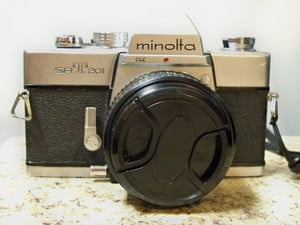Today, many people are finding reasons to try film photography. It doesn’t take much of an investment to get started in film photography. Even some of the most advanced film cameras sell for a fraction of their original prices. Plus, it’s fun to create photographs using vintage equipment. To get into film photography, there are just a few essential things to buy.
First, you’ll need a camera. You can still buy new or new (old stock) 35mm cameras from photography stores, some Amazon sellers, and ebay. Since many people are opting to board the ever moving digital camera technology train, the market place is awash in very nice used film cameras. If you are getting into film photography and want full control over your camera, I’d recommend getting a fully manual 35mm SLR camera with a basic lens. Vintage cameras like the Minolta SRT-201 were sol idly bui lt and often have years of life left in them. Newer models like the Vivitar 3 800 are also excellent cameras . A totally manual camera will help you learn about aperture, shutter speed, film speed, and focusing properly.
Second, you’ll want the camera manual. It’s good to have as a reference and lets you know how to operate the controls of your camera. You can often find the manuals by searching the Internet. Several websites maintain repositories of scanned in camera manuals. If that fails, look for used photography book on Amazon, used books, and thrift stores. You’ll find a wealth of foundational knowledge in a basic primer on photography from the mid-1970s, like “The Book of Photography” by John Hedgecoe and Adrian Bailey. If you are still stymied by the controls on your camera, you might also ask about it on online for um s like the Film Photography.org Forum. Film photography enthusiasts are al wa ys glad to help answer your questions.
Third, you will probably need to get a camera battery. Even fully manual film cameras often have electronic light meters built into the viewfinder to assist in setting the aperture. You can still buy camera batteries at retail stores, but more obscure batteries may require a trip to a camera shop, battery specialty store, or online retailer.
At this point, you could simply add 35mm film and start shooting. However, back in the seventies, Hedgecoe and Bailey recommended a few more accessories like a tripod, a cable release, an electronic flash, an exposure meter (also called a light meter), filters and a filter case, camera cleaning equipment, lens hoods, long lens, wide angle lens, extension tubes, and a camera bag with lens cases. Fortunately some of these items may already be tucked in any camera bag that might come with your vintage camera. In addition, you can get these camera accessories as you learn about them and realize that you have a bona fide need for them.
For each of the film cameras in my personal collection, I like to make sure I have a decent camera bag. That allows me to carry extra film, filters, and other accessories. I also have cleaning supplies including a brush and air blowing bulb to get dust off of lenses. I respect my camera equipment. However, since film cameras have declined in price, I don’t go overboard to protect my gear. After all, you can get a very nice 35mm SLR film camera for less than $50 used.
Sources:
John Hedgecoe, Adrian Bailey, The Book of Photography, Alfred A. Knopf, New York, New York, 1976.
Other articles by this contributor:
Vintage Camera Review: Kodak Retinette 1A 35mm Film Camera
Seven Magnificent Cameras to Save Film Photography
How to Enhance Your Wedding with Film Photography
